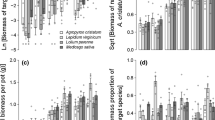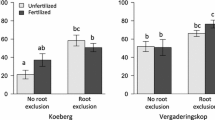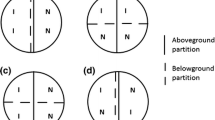Abstract
Mechanisms controlling the successful invasion of resource demanding species into low-resource environments are still poorly understood. Well-adapted native species are often considered superior competitors under stressful conditions. Here we investigate the competitive ability of the resource demanding alien Acacia longifolia, which invades nutrient-poor Mediterranean sand dunes such as in coastal areas of Portugal. We explore the hypothesis that drought may limit invasion in a factorial competition experiment of the alien invasive versus two native species of different functional groups (Halimium halimifolium, Pinus pinea), under well-watered and drought conditions. Changes in biomass, allocation pattern, and N-uptake-efficiency (via 15N-labeling) indicated a marked drought sensitivity of the invader. However, highly efficient drought adaptations of the native species did not provide a competitive advantage under water limiting conditions. The competitive strength of H. halimifolium towards the alien invader under well-watered conditions turned into a positive interaction between both species under drought. Further, low resource utilization by native species benefited A. longifolia by permitting continued high nitrogen uptake under drought. Hence, the N-fixing invader expresses low plasticity by continuous high resource utilization, even under low resource conditions. The introduction of novel traits into a community like N-fixation and high resource use may promote A. longifolia invasiveness through changes in the physical environment, i.e., the water and nutrient cycle of the invaded sand dune system, thereby potentially disrupting the co-evolved interactions within the native plant community.





Similar content being viewed by others
References
Bartelheimer M, Steinlein T, Beyschlag W (2008) 15N-Nitrate-labelling demonstrates a size symmetric competitive effect on belowground resource uptake. Plant Ecol 199:243–253
Baruch Z (1996) Ecophysiological aspects of the invasion by African grasses and their impact on biodiversity and function of neotropical savannas. Ecol Stud 121:79–93
Beyschlag W, Hanisch S, Friedrich S, Jentsch A, Werner C (2009) 15N natural abundances during early and late succession in a middle-European dry acidic grassland. Plant Biol. doi:10.1111/j.1438-8677.2008.00173.x
Blumenthal D (2005) Interrelated causes of plant invasion. Science 310:243–244
Booth MS, Caldwell MM, Stark JM (2003) Overlapping resource use in three Great Basin species: implications for community invasibility and vegetation dynamics. J Ecol 91:36–48
Brooker RW, Maestre FT, Callaway RM, Lortie CL, Cavieres LA, Kunstler G, Liancourt P, Tielborger K, Travis JM, Anthelme F (2008) Facilitation in plant communities: the past, the present, and the future. J Ecol 96:18–34
Call LJ, Nilsen ET (2005) Analysis of interactions between the invasive tree-of-heaven (Alianthus altissima) and the native black locust (Robinia pseudoacacia). Plant Ecol 176:272–285
Callaway RM, Aschehoug ET (2000) Invasive plants versus their new and old neighbors: a mechanism for exotic invasion. Science 290:521–522
Callaway RM, Brooker RW, Choler P, Kikvidze Z, Lortie CJ, Michalet R, Paolini L, Pugnaire FI, Newingham B, Aschehoug ET, Armas C, Kikodze D, Cook BJ (2002) Positive interactions among alpine plants increase with stress. Nature 417:844–848
Chapin FS (1980) The mineral nutrition of wild plants. Annu Rev Ecol Syst 11:233–260
Chapin FSI, Zavaleta ES, Eviner VT, Naylor RL, Vitousek PM, Reynolds HL, Hooper DU, Lavorel S, Sala OE, Hobbie SE, Mack MC, Díaz S (2000) Consequences of changing biodiversity. Nature 405:234–242
Chesson P (2000) Mechanisms of maintenance of species diversity. Ann Rev Ecol Syst 31:343–366
Corbin JD, D’ Antonio CM (2004) Effects of exotic species on soil nitrogen cycling: implications for restoration. Weed Technol 18:1464–1467
Correia O, Martins AC, Catarino F (1992) Comparative phenology and seasonal nitrogen variation in Mediterranean species of Portugal. Ecol Mediterr XVIII:7–18
Crawley MJ (1990) The population dynamics of plants. Philos Trans Biol Sci 330:125–140
Cronk QB, Fuller JL (1995) Plant invaders. Chapman and Hall, London
D’ Antonio CM, Vitousek PM (1992) Biological invasions by exotic grasses, the grass/fire cycle, and global change. Annu Rev Ecol Syst 23:63–87
Daehler CC (2003) Performance comparisons of co-occurring native and alien invasive plants: implications for conservation and restoration. Annu Rev Ecol Syst 34:183–212
Davis MA, Grime JP, Thompson K (2000) Fluctuating resources in plant communities: a general theory of invasibility. J Ecol 88:528–534
Dietz H, Steinlein T (2004) Recent advances in understanding plant invasions. Prog Bot 65:539–573
Dukes JS, Mooney HA (1999) Does global change increase the success of biological invaders? Trends Ecol Evol 14:135–139
Ehrenfeld JG (2003) Effects of exotic plant invasions on soil nutrient cycling processes. Ecosystems 6:503–523
Escudero A, Mediavilla S, Heilmeier H (2008) Leaf longevity and drought: avoidance of the costs and risks of early leaf abscission as inferred from the leaf carbon isotopic composition. Funct Plant Biol 35:705–713
Evans RD, Rimer R, Sperry L (2001) Exotic plant invasion alters nitrogen dynamics in an arid grassland. Ecol Appl 11:1301–1310
Fargione J, Brown CS, Tilman D (2003) Community assembly and invasion: an experimental test of neutral versus niche processes. Proc Natl Acad Sci 100:8916–8920
Funk JL, Vitousek PM (2007) Resource-use efficiency and plant invasion in low-resource systems. Nature 446:1079–1108
Grime JP, Hodgson JG (1987) Botanical contributions to contemporary ecological theory. New Phytol 106:283–295
Große-Stoltenberg A (2009) Impacts of an “invasive engeneer”on the structure of Mediterranean-Atlantic dune and forest phytocoenoses. Diploma-Thesis, University Münster
Grund K, Conedera M, Schröder H, Walther GR (2005) The role of fire in the invasion process of evergreen broad-leaved species. Basic Appl Ecol 6:47–56
Harris MR, Facelli JM (2003) Competition and resource availability in an annual plant community dominated by an invasive species, Carrichtera annua (L. Aschers.), in South Australia. Plant Ecol 167:19–29
Hellmann C, Sutter R (2008) Spatial influences of the N2-fixing invasive Acacia longifolia (Andrews) Willd. on leaf nitrogen traits of three indigenous species and on light interception regimes in a Portuguese dune ecosystem. Bachelor-Thesis, University Bielefeld
Hoagland DR, Arnon I (1950) The water culture method for growing plants without soil. (California Agriculture Experiment Station: Berkeley) Circular No. 347
Hobbs RJ, Huenneke LF (1992) Disturbance, diversity, and invasion: implications for Conservation. Conserv Biol 6:324–337
Högberg P (1997) 15N natural abundance in soil–plant systems. New Phytol 137:179–203
Kowarik I (2003) Biologische Invasionen-Neophyten und Neozoen in Mitteleuropa. Ulmer, Stuttgart
Kramer R (2005) Influence of chilling stress and competition on an alien invasive and native mediterranean species. Staatsexamensarbeit, University Bielefeld
Lambdon PW, Lloret F, Hume PE (2008) Do alien plants on Mediterranean islands tend to invade different niches from native species? Biol Invasion 10:703–716
Liao C, Peng R, Luo Y, Zhou X, Wu X, Fang C, Chen J, Li B (2008) Altered ecosystem carbon and nitrogen cycles by plant invasion: a meta-analysis. New Phytol 177:706–714
MacArthur RH (1972) Geographical ecology: patterns in the distribution of species. Princeton University Press, Princeton, NJ
Marchante H, Marchante E, Freitas H (2003) Invasion of the Portuguese dune ecosystems by the exotic species Acacia longifolia (Andrews) Willd.: effects at the community level. In: Child LE, Brock JH, Brundu G, Prach K, Pyšek P, Wade PM, Williamson M (eds) Plant invasions: ecological threats and management solutions. Backhuys Publishers, The Netherlands, Leiden, pp 75–85
Marchante H, Marchante E, Buscardo E, Maia J, Freitas H (2004) Recovery potential of dune ecosystems invaded by an exotic acacia species (Acacia longifolia). Weed Technol 18:1427–1433
Marchante E, Kjoller A, Struwe S, Freitas H (2008a) Short- and long-term impacts of Acacia longifolia invasion on the belowground processes of a Mediterranean coastal dune ecosystem. Appl Soil Ecol 40:210–217
Marchante E, Kjoller A, Struwe S, Freitas H (2008b) Invasive Acacia longifolia induce changes in the microbial catabolic diversity of sand dunes. Soil Biol Biochem 40:2563–2568
Marchante E, Kjoller A, Struwe S, Freitas H (2009) Soil recovery after the removal of the N2-fixing invasive Acacia longifolia: consequences for ecosystem restoration. Biol Invasion. doi:10.1007/s10530-008-9295-1
Maron JL, Jefferies RL (1999) Bush lupine mortality, altered resource availability, and alternative vegetation states. Ecology 80:443–454
McKane RB, Johnson LC, Shaver GR et al (2002) Resource-based niches provide a basis for plant species diversity and dominance in Arctic Tundra. Nature 6867:68–70
McKenney JL, Cripps MG, Price WJ, Hinz HL, Schwarzländer M (2007) No difference in competitive ability between invasive North American and native European Lepidium draba populations. Plant Ecol 193:292–303
Miller TE, Burns JH, Munguia P, Walters EL et al (2005) A critical review of twenty years’ use of the resource-ratio theory. Am Nat 186:439–448
Mooney HA, Hobbs RJ (eds) (2000) Invasive species in a changing world. Island Press, Washington, DC
Naeem S, Knops JM, Tilman D, Howe KM, Kenndy T, Gale S (2000) Plant diversity increases resistance to invasion in the absence of covarying extrinsic factors. Oikos 91:97–108
Ortmeier K (2007) Importance of nursery plants for invasive process of Acacia longifolia in Portuguese dune ecosystems. Diploma Thesis, University Bielefeld
Peperkorn R (2005) Key factors of invasiveness of Acacia longifolia—experimental comparison with native species from Mediterranean sand ecosystems. PhD thesis
Peperkorn R, Werner C, Beyschlag W (2005) Phenotypic plasticity of an invasive acacia versus two native Mediterranean species. Funct Plant Biol 32:933–944
Pereira AJ, Evangelista H, Marchante H, Marchante E, Schreck C, Freitas H, Ramos M, Correia O, Máguas C (2004). Water use in dune ecosystems: native versus invasive species (Acacia longifolia). In: Procedings: VII Simposio Luso-espanhol de Relações Hidricas em plantas, pp 163–166
Rascher KG, Máguas C, Correia O, Werner C (2009) Tracing seasonal changes in water use of an invasive Acacia and a native Pine in Southern Portugal by measurement of sap flow. Acta Horticulturae (in press)
Richardson DM, Pyšek P (2006) Plant invasions: merging the concepts of species invasiveness and community invasibility. Prog Phys Geogr 30:409–431
Rodriguez-Echeverría S, Crisóstomo JA, Nabais C, Freitas H (2009) Belowground mutualists and the invasive ability of Acacia longifolia in coastal dunes of Portugal. Biol Invasions 11(3):651–661
Sperry JS, Hacke UG, Oren R, Comstock JP (2002) Water deficits and hydraulic limits to leaf water supply. Plant Cell Environ 25:251–263
Stock WD, Wienand KT, Baker AC (1995) Impacts of invading Nitrogen-fixing acacia species on patterns of nutrient cycling in two cape ecosystems: evidence from soil incubation studies and 15N natural abundance values. Oecologia 101:375–383
Theoharides KA, Dukes JS (2007) Plant invasion across space and time: factors affecting nonindigenous species success during four stages of invasion. New Phytol 176:256–273
Tilman D (1980) Resources: a graphical-mechanistic approach to competition and predation. Am Nat 116:362–393
Tilman D (1985) The resource-ratio of plant succession. Am Nat 125:827–852
Tilman D (2004) Niche tradeoffs, neutrality, and community structure: a stochastic theory of resource competition, invasion, and community assembly. Proc Natl Acad Sci USA 101:10854–10861
Vila M, Weiner J (2004) Are invasive plant species better competitors than native plant species?—evidence from pair-wise experiments. Oikos 105:229–238
Vitousek PM (1994) Beyond global warming: ecology and global change. Ecology 75:1861–1876
Vitousek PM, Walker LR (1989) Biological invasion by Myrica faya in Hawaii: plant demography, nitrogen fixation, ecosystem effects. Ecol Monogr 59:247–265
Werner C, Correia O (1996) Photoinhibition in cork-oak leaves under stress: influence of the bark-stripping on the chlorophyll fluorescence emission in Quercus suber L. Trees 10:288–292
Werner C, Correia O, Beyschlag W (1999) Two different strategies of Mediterranean macchia plants to avoid photoinhibitory damage by excessive radiation levels during summer drought. Acta Oecol 20:15–23
Werner C, Ryel RJ, Correia O, Beyschlag W (2001) Structural and functional variability within the canopy and its relevance for carbon gain and stress avoidance. Acta Oecol 22:1–10
Werner C, Correia O, Beyschlag W (2002) Characteristic patterns of chronic and dynamic photoinhibition of different functional groups in a Mediterranean ecosystem. Funct Plant Biol 29:999–1011
Werner C, Peperkorn R, Máguas C, Beyschlag W (2008) Competitive balance between the alien invasive Acacia longifolia and native Mediterranean species. In: Tokarska-Guzik B, Brock JH, Brundu G, Child L, Daehler CC, Pyšek P (eds) Plant invasions: human perception, ecological impacts and management. Backhuys Publishers, Leiden, The Netherlands, pp 261–275
Witkowski ETF (1991a) Effects of invasive alien Acacias on nutrient cycling in the coastal lowlands of the Cape Fynbos. J Appl Ecol 28:1–15
Witkowski ETF (1991b) Growth and competition between seedlings of Protea repens L. and the alien invasive, Acacia saligna (Labill.) Wendl. in relation to nutrient availability. Funct Ecol 5:101–110
Yelenik SG, Stock WD, Richardson DM (2004) Ecosystem level impacts of invasive Acacia saligna in the South African Fynbos. Rest Ecol 12:44–51
Zunzunegui M, Díaz Barradas MC, García Novo F (2000) Different phenotypic response of Halimium halimifolium in relation to groundwater availability. Plant Ecol 148:165–174
Acknowledgments
This work has been funded by the Deutsche Forschungsgemeinschaft (Transdune, WE 2681/3-1) and the FCT (POCTI/BSE/34689/2000). We acknowledge valuable comments from K. Rascher and significant technical support during the experiment and isotope analysis from E. Furlkröger and B. Teichner, respectively.
Author information
Authors and Affiliations
Corresponding author
Rights and permissions
About this article
Cite this article
Werner, C., Zumkier, U., Beyschlag, W. et al. High competitiveness of a resource demanding invasive acacia under low resource supply. Plant Ecol 206, 83–96 (2010). https://doi.org/10.1007/s11258-009-9625-0
Received:
Accepted:
Published:
Issue Date:
DOI: https://doi.org/10.1007/s11258-009-9625-0




